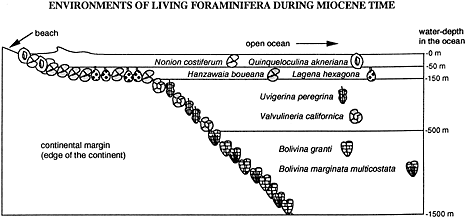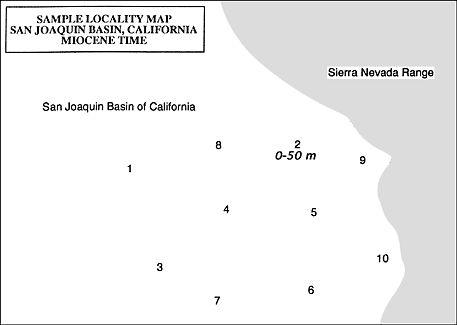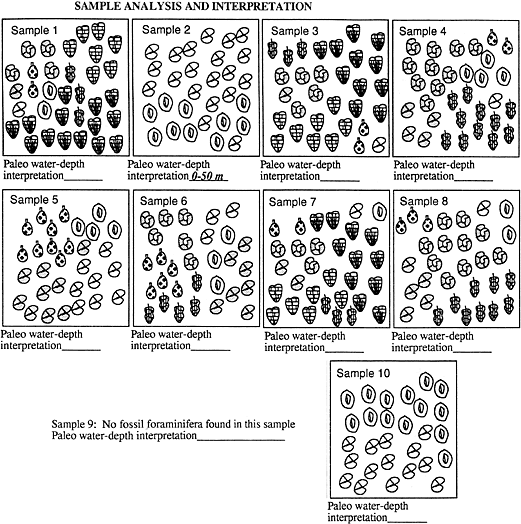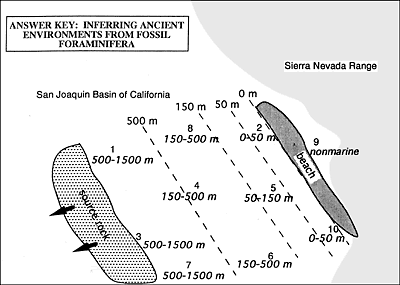INFERRING ANCIENT ENVIRONMENTS
FROM FOSSIL FORAMINIFERA,
A
CLASSROOM ACTIVITY
HILARY CLEMENT OLSON
INTRODUCTION
Age Level: This activity is appropriate for middle school students in seventh or
eighth grade. It may be adapted for use with high school biology students.
Prerequisites: In order to complete this activity, the student should have a concept
of the foraminifera and how different benthic foraminifera prefer a particular environment
which may be associated with water-depth. The student should also have had an introduction
to the concept of geologic time and feel comfortable working with a map. Familiarity with
the concepts of petroleum reservoir rock and source rock from studies of earth sciences is
useful. Introduce the concept that benthic foraminifera live in a preferred environment; but,
after their death their shells may be transported to a different environment. Transportation
occurs downslope due to gravity processes. Therefore, in a sample the students will find a
mixture of foraminifera, specifically a death assemblage, representing foraminifera living at
one time in that environment and foraminifera transported from shallower water-depths into
that environment. Guide the students to initiate the mental leap of understanding that in order
to interpret the water-depth in which the foraminifera were deposited and later buried, the
deepest dwelling forms represent the true water-depth. Specifically, at a present water-depth
of 1,000 m, foraminifera will be found there which preferred to live in that environment as
well as foraminifera which were brought in from shallower water by downslope processes
(i.e., the Amazon Fan moves sediment, including foraminifera, in a downslope direction off of
Brazil). Foraminifera preferring parameters characteristic of water-depths greater than 1,000
m would not be found at this sight. The students should interpret past water-depth based on
the deepest dwelling form found in the sample.
Objective: Each student will use a reference diagram of fossil foraminifera with
their paleo-water-depth assignments to interpret the water-depth of a particular area of
California during the geologic past. The model of paleoenvironments and the species found in
the samples are based on actual work by Ingle (1980) and Olson (1990). The reconstruction
of Miocene environments is applied to the petroleum industry by looking for potential
reservoir rock and source rock.
Follow-Up: If you write to the author of this article, she will send you a reprint of
Olson (1990) which contains actual S.E.M. photographs of the various species mentioned in
this activity. Actual sample material containing foraminifera from the Miocene of California
will be included with the request, availability permitting. Requesting a reprint from a scientist
is an excellent way to demonstrate how communication occurs between scientists in similar
fields. My students were amazed to discover that a person could request a reprint of a journal
article from an author at no charge. We also included a discussion of the differences between
a magazine and a professional journal, including an explanation of the peer-review process.
This process is conducted by most professional journals. When an author submits a scholarly
work for publication, the journal editor sends the article to several authorities (peers) in the
field for review. These reviews can be quite critical but often contain insightful comments
and suggestions. The author, upon receipt of the reviews, may make changes or substantiate
arguments before returning the revised manuscript to the editor for publication. Peer-review
reflects an important aspect of the scientific process: all work should be made available for
public scrutiny and debate by other scientists in the field.
 Return to top Return to top
REFERENCES
Ingle, James C., Jr., 1980, Cenozoic paleobathymetry and depositional history of selected
sequences within the southern California continental borderland, Memorial to Orville L.
Bandy, Cushman Foundation Special Publication no. 19, p. 163-195.
Olson, Hilary Clement, 1990, Early and middle foraminiferal paleoenvironments,
southeastern San Joaquin basin, California, Journal of Foraminiferal Research, v. 20, no. 4, p.
289-311.
INFERRING ANCIENT ENVIRONMENTS FROM FOSSIL FORAMINIFERA
Instructions: Follow the instructions given below and those of your teacher to
complete this activity.
1) Examine Figure 1 to learn about the habitats of benthic foraminifera during Miocene time
(6 Ma ). For this exercise, the Miocene ocean is divided into four zones based on water-
depth: (1) 0 - 50 m; (2) 50-150 m; (3) 150-500 m; and (4) 500-1500 m. The names of the
foraminifera which prefer each environment are listed and a schematic drawing for each
species is shown. As a research scientist for Earthquest Inc., you have been assigned to work
in a field area in the southeastern part of the San Joaquin Basin of California. Earthquest Inc.
is interested in the Miocene rocks of this area because in other parts of the basin, age equivalent rocks contain petroleum reserves. Your job is to collect samples and discover what
environments were present here approximately 6 Ma. Specifically, beach sands have been
found to be good reservoir rocks for containing oil. Silt and clay sediments with abundant
organic material deposited in water-depths of greater than 1,000 m have been found to be
good source rocks for oil. Your job is to evaluate the potential for both good reservoir rock
and source rock in the study area.


 Return to top Return to top
2) Figure 2 is a map of the different localities you chose to sample in the study area. Notice
that the basin you are studying is bordered to the east by the Sierra Nevada Range. There are
10 samples collected from Miocene rocks. You disaggregate the sample material to obtain
any microfossil material, specifically foraminifera, from the rock. Next, you examine the
fossil material and sediment under a microscope. Your analysis of the various samples is
shown in Figure 3.


 Return to top Return to top


3) You must now make an interpretation for water-depth for the various samples you have
analyzed. Notice that each box displays the various foraminiferal species found in the sample.
Compare each sample in Figure 3 with the key to Miocene environments in Figure 1. In the
blank for paleo-water-depth interpretation under each sample, put a water-depth range
inferred from your analysis. Notice that Sample 2 has been interpreted for you. What would
cause the lack of foraminifera in Sample 9? Look at the sample's position relative to other
samples on the map in Figure 2.
 Return to top Return to top
4) After you have made an interpretation for each sample, mark these paleo water-depth
numbers on your map (Figure 2). Notice that the interpretation for Sample 2 has been done
for you. Look at the distribution of water-depths on your map. Based on this information
could you give an estimate of where the beach was located during Miocene time in the study
area? Using a colored pencil, highlight and label the potential trend of the beach (shoreline)
and its location. Do you see potential for source rocks in the study area during this time? If
you do, highlight and label the potential source rock area with a different colored pencil.
State your recommendation to Earthquest Inc. below.
Recommendation on reservoir rock:_____present_____absent.
Recommendation on source rock:_____present_____absent.
Description of the general environment of this area during Miocene time:



|